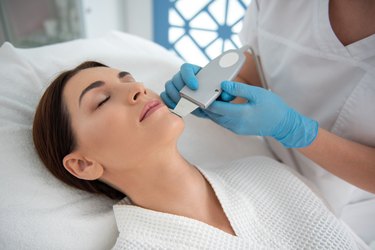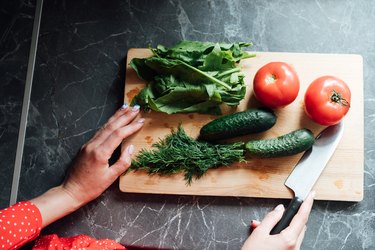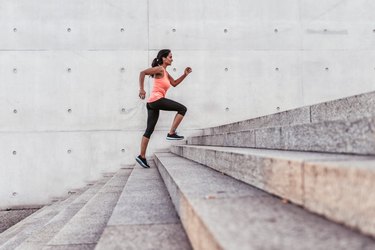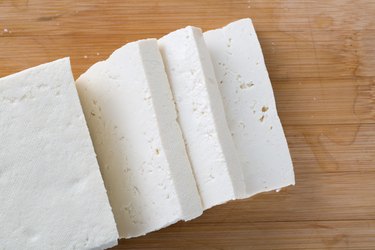
Does your weight-loss goal involve having a healthier looking face? If you've been wondering how to lose facial and cheek fat, it's important to know that you can't just get rid of it by simply exercising it away.
Though facial exercises can improve the appearance of double chins or chubby cheeks somewhat, the surest way to get rid of facial and cheek fat is by losing weight all over your body — and that means adopting a lifestyle of eating healthier food and getting regular exercise. Read on to learn more.
Video of the Day
Video of the Day
Exercise and Face Fat
As a May 2021 article from the Cleveland Clinic points out, there's no quick fix for a double chin. "Typically, a double chin corresponds with carrying excess weight," they note. "Anyone following a healthy diet and exercising an hour a day is going to lose weight and see it in their face."
Aging is another cause of face fat. "With age ... fat loses volume, clumps up and shifts downward, so features that were formerly round may sink, and skin that was smooth and tight gets loose and sags," explains a February 2021 article from Harvard Health Publishing. "Meanwhile other parts of the face gain fat, particularly the lower half, so we tend to get baggy around the chin and jowly in the neck."
That said, the Clinic does describe two things that might improve the appearance of a double chin a bit: jaw-exercise tools and so-called "double-chin exercises."
Jaw-Exercise Tools
Jaw-exercise tools are little devices that exercise your neck and face muscles when you bite down on them. "With proper use, they may help improve the jawline by increasing the jaw muscles," says the Clinic.
Double-Chin Exercises
Certain double-chin exercises may give you stronger neck muscles, says the Clinic, "but that doesn't mean they will rid you of chin fat."
However, a small, limited study published in the March 2018 issue of JAMA Dermatology found that doing 30 minutes of muscle-resistant facial exercises at home every day or every other day for 20 weeks did seem to improve participants' facial appearance. "The mechanism may be exercise-actuated hypertrophy of cheek and other muscles," noted researchers. "Further research is warranted."
Other Causes of Facial Fullness
Sometimes it isn't fat that makes a face appear fuller — it's water retention, aka bloating. Prime culprits in this case are alcohol consumption and excess sodium from processed foods. Controlling those two factors (and staying hydrated, so your body doesn't feel compelled to hold on to fluid) will help matters.
Facial tools such as a gua-sha stone and jade roller may also temporarily reduce the puffiness. A small study published in the December 2018 edition of the journal Complementary Therapies in Medicine found "mechanical stimulation by a facial massage roller exerted both short- and long-term effects on skin blood flow and the dilatation response solely in the region where the massage was applied."
Similarly, using a gua-sha tool in a gentle, upward "scraping" motion can also promote good circulation and alleviate facial swelling, as described by an article published by the Cleveland Clinic in June 2021. "Gua sha has been proven to help relieve tension in the face, reduce puffiness and inflammation," they note. When it comes to using jade rollers or gua-sha tools specifically to treat double chins and chubby cheeks, however, more research is needed.
Weight Loss and Face Fat
Fat is stored in adipose cells all over your body. Whenever you create a calorie deficit — meaning that you burn more calories than you consume — your body converts some of this fat into energy. But where it takes the fat from is genetically set; in other words, you can't tell your body to use face and cheek fat first. Lose weight in general and, with time, some of it will come from your cheeks and chin.
Losing Body Weight
When you have a lot of fat in your face, chin and neck, you may look heavier than you are. Slimming down the area can give you a much leaner appearance, since your chin and cheekbones will become more pronounced.
If you're overweight, losing pounds will make your face and neck (and the rest of your body) thin out. A calorie deficit that involves consuming fewer calories than you burn is key. Use an online calorie calculator such as the one offered by the National Academy of Sports Medicine to determine your adjusted daily caloric intake based on your age, gender, size, activity level and goal weight. Generally speaking, cutting 500 calories a day from your usual intake amount results in a weight loss of 1 pound per week.
Eating smaller portions of healthy foods will aid you in shaving calories from your daily intake. But don't go overboard in hopes of slimming your face and neck: If your daily calorie intake gets too low — below 1,200 for a woman or 1,800 for a man — it can slow your metabolism and lead to muscle loss. Such a low calorie intake can also lead to nutritional deficiencies and feelings of extreme hunger, potentially weakening your willpower.
Eat for a Healthier Looking Face
Vegetables, fruits, low-fat dairy, lean proteins and whole grains make up a quality diet that promotes weight loss and a healthier looking face and neck. For easy portion control, fill half your plate with leafy greens or other watery, fibrous vegetables such as kale, spinach, lettuce, green beans, broccoli and eggplant. Another quarter of your plate should contain whole grains, such as brown rice or barley.
The final quarter of your plate should consist of lean protein, such as eggs, white-meat chicken, fish or lean steak. Eating lots of healthy protein is particularly important when you're trying to lose fat, because it causes you to feel full at meals and discourages your body from burning muscle. "Adding more protein to your diet may help you feel full longer," explains an October 28, 2022, article from the Cleveland Clinic. "Increasing the amount of protein you eat can help reduce the buildup of harmful fats in your body."
Exercise to Lose Face Fat
Focusing on total-body cardiovascular exercise such as brisk walking or cycling will burn calories and cause you to lose fat all over your body — including your face. Do 30 minutes of aerobic activity a day, along with 30 minutes of strength training at least three days a week. Dumbbells, leg presses, pull-up bars and resistance bands can all be used.
"If you're trying to lose weight, you should aim for doing cardio at least five days per week for a total of at least 250 minutes (4 hours, 10 minutes) each week," says Michigan's Corewell Health system. "For optimal benefits, you should incorporate both cardio and strength training into your exercise routine."
Squats and the like may not seem to have anything to do with your face. But consistently doing those and other fitness moves will eventually make your body (and your face) leaner.
Tip
If you choose to exercise outside, make sure you apply sunscreen to protect the skin on your face from sun damage, which prematurely ages you by breaking down the proteins that keep skin strong and supple.
Losing facial fat goes hand-in-hand with losing weight overall. To see results, you have to be consistent. If you try not to skip exercise or fall back on previous (read: unhealthy) eating habits, a healthier looking face could be your reward.
If you are unsuccessful at losing facial fat on your own, you can meet with a plastic surgeon to discuss your options. Noninvasive cryolipolysis is one procedure that can target and reduce facial fat, as described in the June 2020 issue of Aesthetic Surgery Journal Open Forum. Other procedures that remove excess facial fat include facelifts and liposuction.
Warning
Check with your healthcare provider before starting any exercise program, especially if you have chronic health issues or haven't exercised in a while.
- Harvard Health Publications: Why Your Face Ages and What You Can Do
- National Institute of Diabetes and Digestive and Kidney Diseases: Weight Loss and Nutrition Myths
- Cleveland Clinic: "How to Get Rid of a Double Chin"
- Harvard Health Publishing: "Why Your Face Ages and What You Can Do"
- Complementary Therapies in Medicine: "Short- and Long-Term Effects of Using a Facial Massage Roller on Facial Skin Blood Flow and Vascular Reactivity"
- Cleveland Clinic: "Why Gua Sha Is Good for You"
- JAMA Dermatology: "Association of Facial Exercise With the Appearance of Aging"
- National Academy of Sports Medicine: "NASM's Calorie Calculator"
- Cleveland Clinic: "4 Ways Protein Can Help You Shed Pounds"
- Aesthetic Surgery Journal Open Forum: "Cryolipolysis: Clinical Best Practices and Other Nonclinical Considerations"
- Corewell Health: "Cardiovascular Training Vs. Strength Training for Weight Loss"




